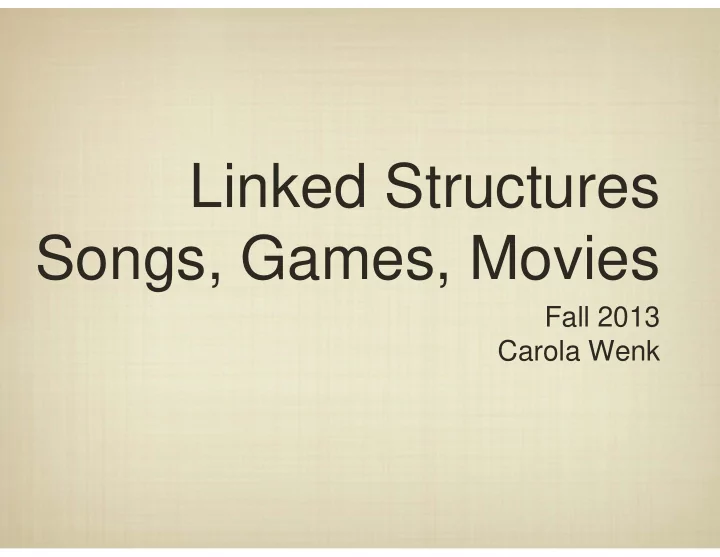

Linked Structures Songs, Games, Movies Fall 2013 Carola Wenk
The Big Picture (So Far) Worst-case analysis of running time, Algorithms simple linear-time algorithms, and efficient searching and sorting. Python: variables, loops, if-then, Software functions, lists, recursion Von Neumann architecture, logic, Hardware gates, circuits, binary numbers, machine instructions
Algorithms So Far Selection Merge Sort Sort Minimum, Maximum, Linear Search Binary Search Interestingly, these performance trends comprise a large fraction of algorithms - why?
Roadmap • Application areas that seem drastically different are often tied together by algorithms: Making a phone call Embedded Systems Listening to music Surfing the web Multimedia, Networking Playing a game Looking for aliens Search and Optimization Curing cancer Artificial Intelligence and Machine Playing Jeopardy Learning Telepathic control Algorithm development also brings up the question: what abstract problems are efficiently solvable ?
Overview • Media and games must organize data in order to provide a unique user experience (to make $$$). 1. How are thousands of songs managed on a mobile device? 2. How do we actually “play against the computer” in a game?
Songs and Movies An iPod can store up to 40K songs. Hard Drive Song Song Song Song Song Song/Video CPU Memory App App App Are media “objects” just stored as a list? How can we quickly find/add/remove items?
Songs and Movies An iPod can store up to 40K songs. Hard Drive iOS 6/Android Song Song Song Song Song Song/Video CPU Memory App App Media App Player Are media “objects” just stored as a list? How can we quickly find/add/remove items?
Array-based Lists • Recall that we were able to access any element of a list in constant time. How is this possible? 0 1 2 3 ... Lists are actually stored L: contiguously as an array of Data memory locations; we can access any element using simple arithmetic. The physical location of the i- th element is just i memory Instructions locations from the beginning of the list.
Modifying Large Arrays 0 0 1 1 2 2 3 . 3 . . . . . • How is a list of songs actually structured into an array?
Modifying Large Arrays 0 MP3 0 1 MP3 1 2 2 MP3 3 . 3 MP3 . . . . . • If we store the list of songs as an array, then what do we do when we add content to our library?
Modifying Large Arrays 0 0 1 MP3 1 2 MP3 3 2 MP3 . 3 . MP3 . . MP3 . copy . down • To insert a song into this list, we have to restructure the contiguous storage to be larger, and shift elements down.
Modifying Large Arrays 0 0 1 1 2 3 2 . 3 . . . . copy . down • In the worst case, we have to move the entire list to add or remove entries. Syncing would be a nightmare!
Creating New Types Fundamentally, the problem of adding new data is that there is no room in an array. We need a different data structure that is more “spaced out”. What we really need is a way to consider items separately and link/string them together like “beads”. Using indirection, we can create our own “type” in Python that allows us to dynamically grow a collection of items.
Dynamic Lists (Linked List) Static 0 1 L: 55 99 ... Dynamic (Linked) somewhere in memory L: ... 55 99 In the dynamic list (= linked list), each element has a value, as well as what is “next” to it in the list.
Dynamic Lists (Linked List) Static 0 1 L: 55 99 ... Dynamic (Linked) somewhere in memory L: ... 55 99 How do we add an item to a dynamic list?
Dynamic Lists (Linked List) Static 0 1 L: 55 75 99 ... shift items Dynamic (Linked) somewhere in memory L: ... 55 99 How do we add an item to a dynamic list?
Dynamic Lists (Linked List) Static 0 1 L: 55 75 99 ... shift items Dynamic (Linked) somewhere in memory L: ... 55 99 75 Because each list element explicitly stores where it’s neighbor is, to add an element to the dynamic list, we just need to assign a new neighbor.
Dynamic Lists (Linked List) Static 0 1 L: 55 75 99 ... shift items (linear time) Dynamic (Linked) somewhere in memory L: ... 55 99 75 In contrast to the static list, we only need to perform a constant amount of work to add an item to the dynamic list.
Dynamic Lists (Linked List) Static 0 1 L: 55 75 99 ... Dynamic (Linked) somewhere in memory L: ... 55 99 75 This data structure is often referred to as a linked list.
Dynamic Lists (Linked List) Static 0 1 L: 55 75 99 ... Dynamic (Linked) somewhere in memory L: ... 55 99 75 To implement a linked list, we need to create a new type that carries both data and a reference to the “next” item.
A List Node class Node: def __init__(self, data): how will a variable of self.data = data this type be initialized? self.next = None how can we print the def __str__(self): contents of this return str(self.data) variable? x = Node('hello') y = Node('world!') x.next = y print x print x.next x: y: ‘hello’ ‘world!’
Linked Structures Dynamic data structures allow us to specifically design how information is “laid out”. This is one of the keys to enabling the efficient storage and retrieval of media content on mobile and embedded devices.
Recommend
More recommend